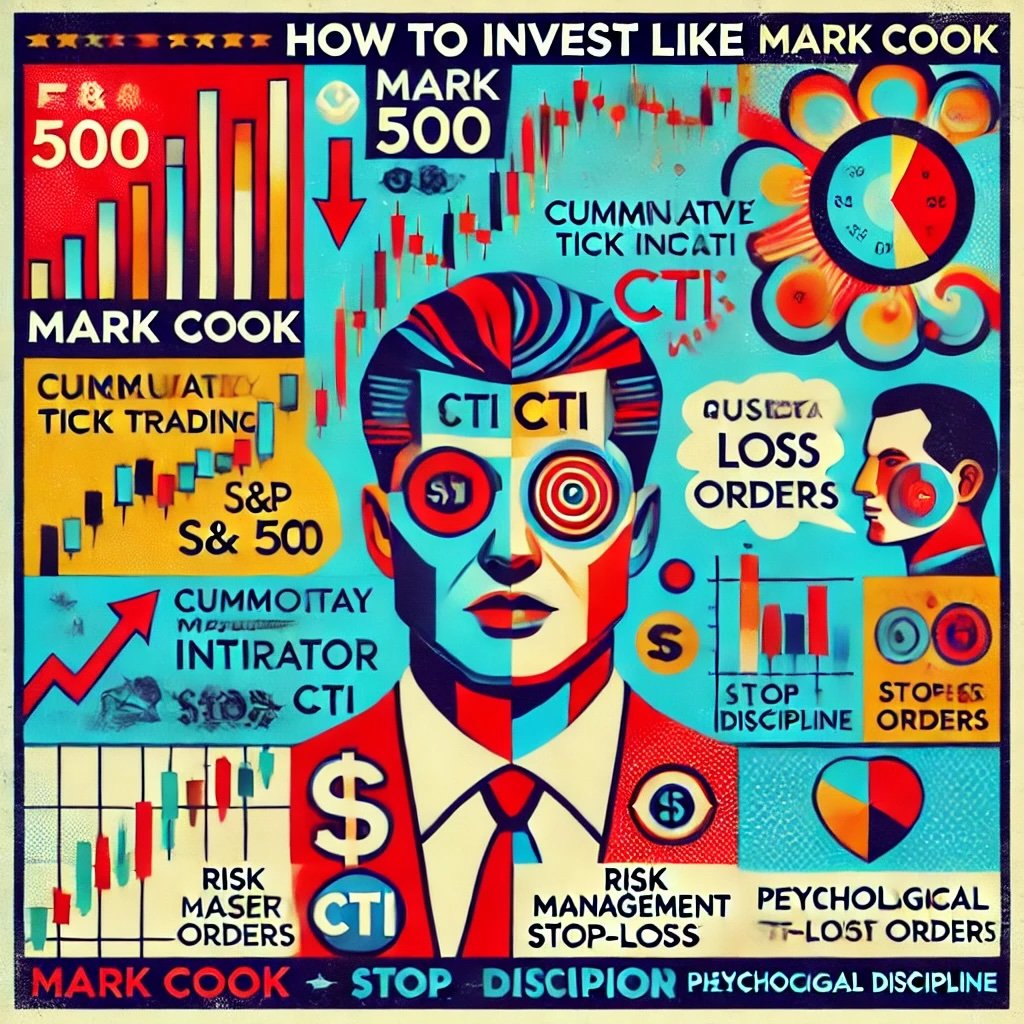In the dynamic world of asset management, new products and technologies make headlines almost daily. From exchange-traded funds (ETFs) to robo-advisors, innovative investment tools promise better returns, lower fees, and more flexibility. But amid this flurry of innovation, it’s easy to forget that legacy mutual funds—some of which have been around for decades—continue to play a vital role in many investors’ portfolios. Indeed, these “old funds” can still pack a punch.
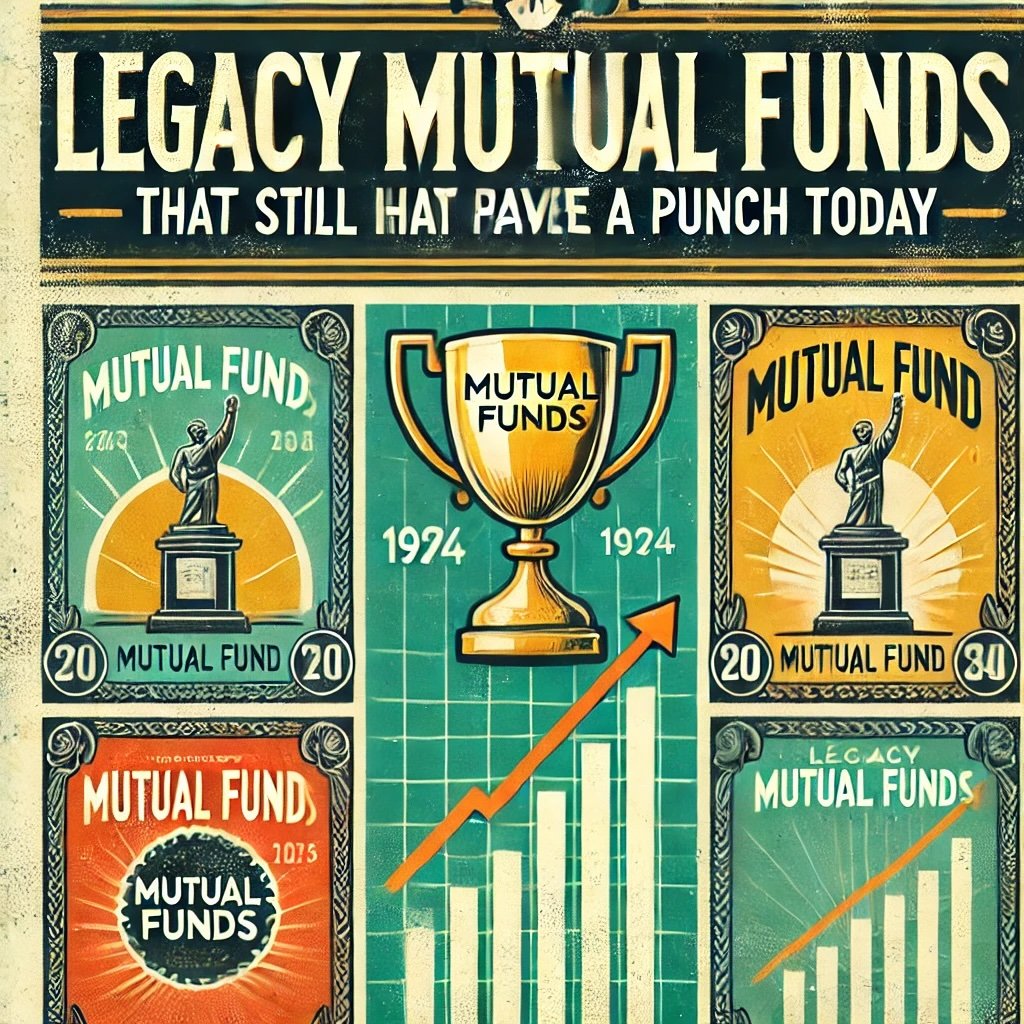
They’re not obsolete.
In fact, many of these funds have steered through numerous market cycles, weathering wars, recessions, bubbles, and technological revolutions. They’ve consistently returned value to shareholders while adapting—sometimes slowly, but steadily—to the evolving landscape of finance. That is no small feat. Very few financial instruments have the track record and brand loyalty that these established funds command.
But what exactly qualifies a mutual fund as “legacy”? How do these older funds manage to remain relevant in an era increasingly dominated by index investing and digital platforms? Why would an investor choose to stick with a product launched, say, in the 1970s or ‘80s, rather than chase the allure of newer, niche funds or advanced quantitative strategies? The answers lie in their long-term performance, experienced management teams, and the trust they’ve built over time.
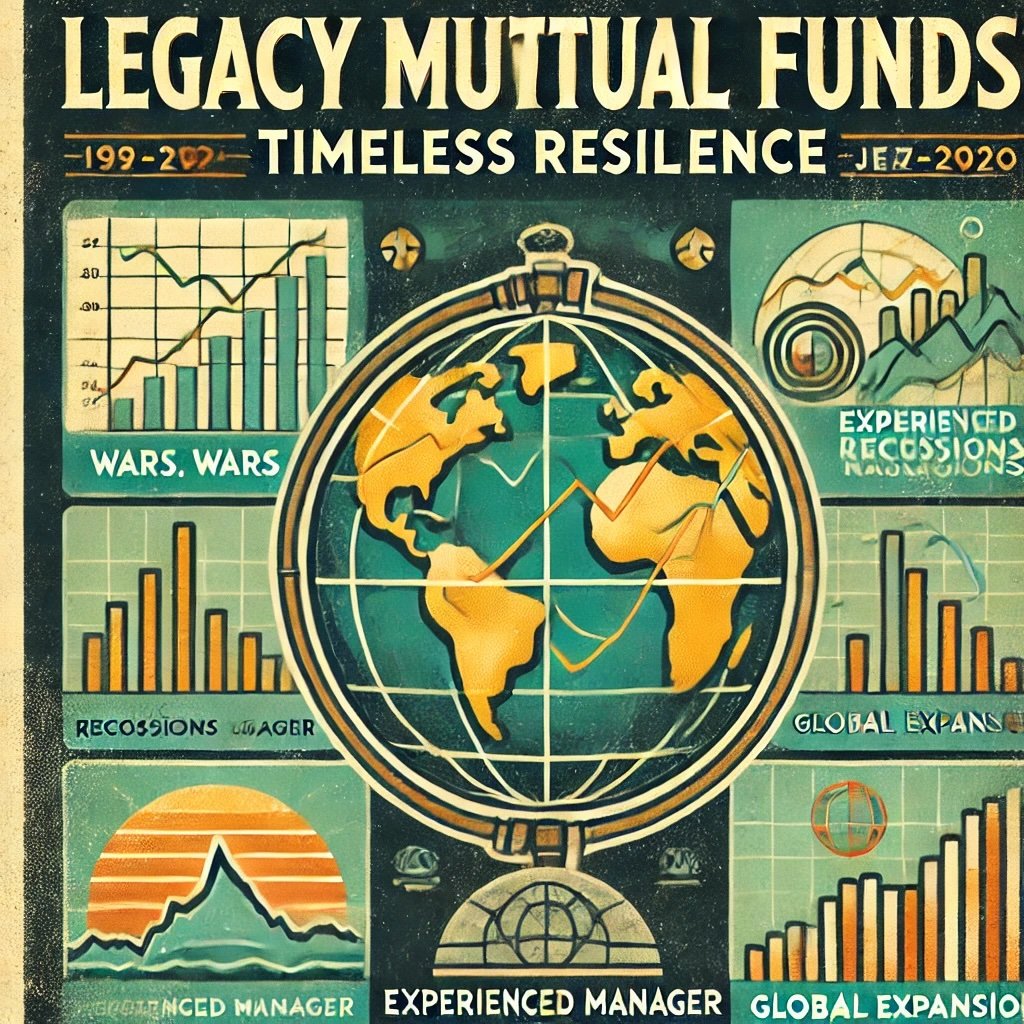
We’ll walk through a structured exploration of legacy mutual funds: how they differ from more modern offerings, what advantages they bring to the table, and which ones continue to impress despite their age. We’ll also consider the potential pitfalls—like higher fees and occasional underperformance—so you can decide whether these time-tested investment vehicles align with your financial goals. After all, a balanced perspective is crucial. Some old funds stand the test of time, while others fail to adapt and inevitably fade from investor preference.
The mutual fund industry has grown immensely since its inception in the early 20th century, and many argue that the big shifts in regulation, distribution, and technology have made older funds less competitive. But as you’ll see, plenty of these longstanding portfolios have expanded globally, refined their strategies, and employed seasoned management teams to remain top performers. The old can still teach the young a lesson or two in the realm of asset management.
So let’s dive in, starting with a clear definition of what exactly we mean by legacy mutual funds and why these historical juggernauts continue to attract billions of dollars in investor capital—despite a marketplace flooded with shiny new alternatives.
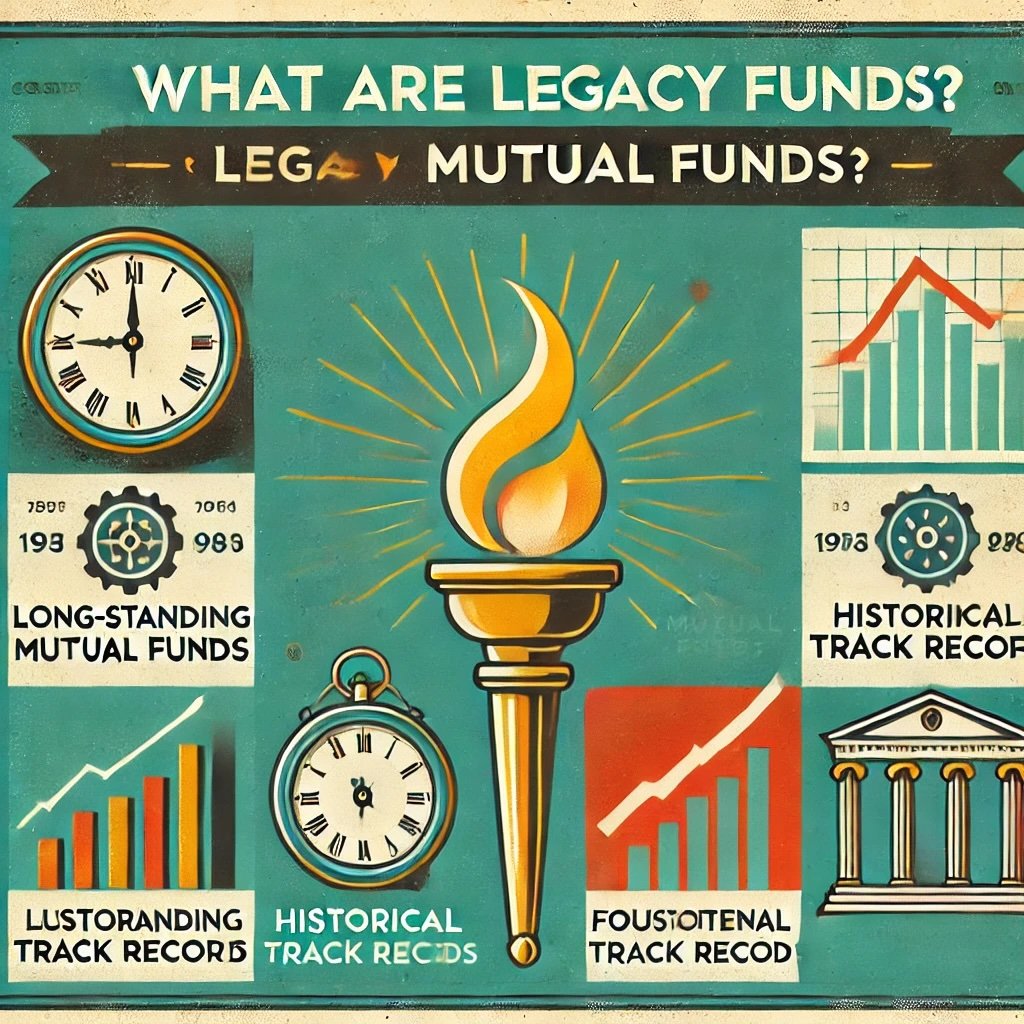
What Are Legacy Mutual Funds?
A legacy mutual fund is typically one that has been around for a lengthy period, often 20 years or more, and in some cases, half a century or longer. These funds usually have well-established brand names, with a track record stretching through multiple market cycles. You’ll often find them in lists of oldest or largest mutual funds, managed by companies such as Vanguard, Fidelity, T. Rowe Price, or American Funds. Their continuity gives them a certain gravitas in the financial world.
Defining Characteristics
- Long Track Record
A true “legacy” fund isn’t just a decade old. It can be measured against major historical market events: the dot-com bubble of the late ‘90s, the 2008 financial crisis, the COVID-19 recession, and so forth. Over such an extended period, these funds build a performance history that analysts, advisors, and retail investors can study in detail. - Experienced Management
While mutual fund managers do change over time, many legacy funds tout teams or management styles with roots stretching back decades. Even if the original manager has retired, the fund company often grooms successors who share the same investment philosophy, ensuring continuity in strategy. - Historical Resilience
A hallmark of many older funds is the ability to survive (and even thrive) through bear markets, recessions, and black swan events. Funds that imploded or underperformed drastically during crises were likely liquidated or merged into other funds. Those that remain have proven resilient in some sense. - Foundation of the Mutual Fund Industry
Legacy funds are, in many ways, institutional cornerstones. For instance, the Vanguard 500 Index Fund, launched in 1976, pioneered index investing for individuals. Fidelity Contrafund began in the 1960s, paving the way for actively managed growth strategies. These funds shaped investment philosophies that modern offerings continue to emulate or refine.
They built the framework.
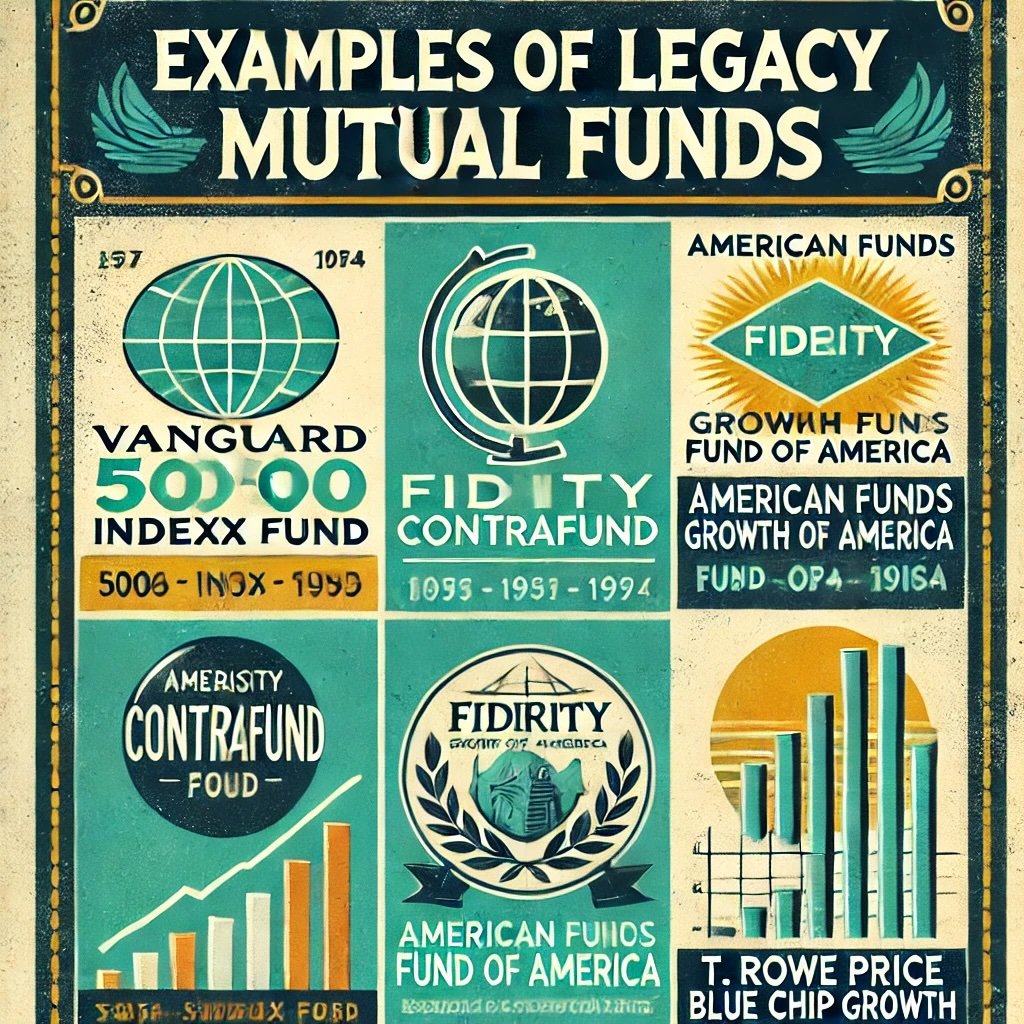
Examples
- Vanguard 500 Index Fund (VFINX): Launched by Jack Bogle, credited with popularizing index investing.
- Fidelity Contrafund (FCNTX): Known for its long-standing and well-respected manager, Will Danoff, who’s been at the helm since 1990.
- American Funds Growth Fund of America (AGTHX): Established in the 1970s, focusing on large-cap growth stocks with a tilt toward global opportunities.
- T. Rowe Price Blue Chip Growth (TRBCX): A staple for many seeking exposure to seasoned, large-cap, blue-chip names.
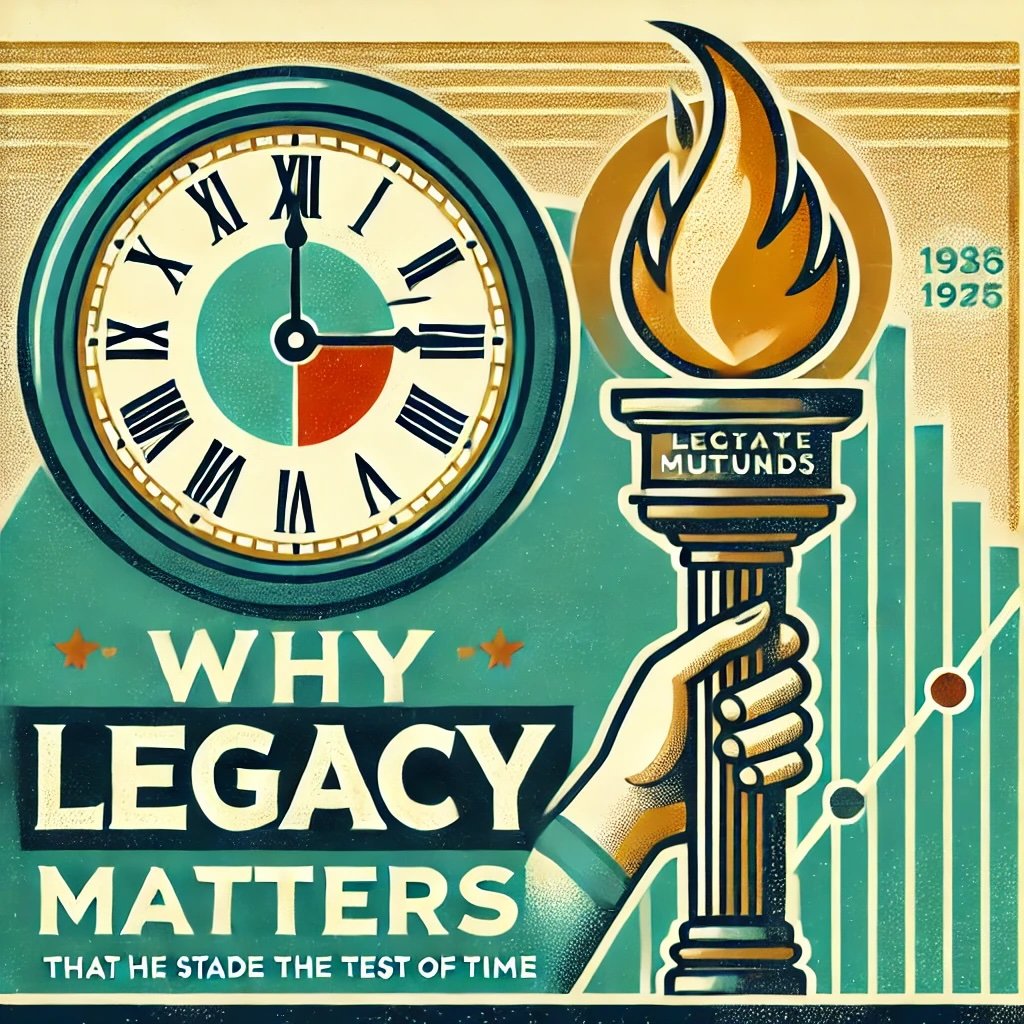
Why “Legacy” Matters
In a fast-moving financial market, the word “legacy” can sometimes have a negative ring—implying outdated technology or stale methods. Yet in mutual fund investing, longevity is often seen as a positive trait. Why? Because if a fund has navigated multiple economic storms and still delivers competitive returns, it’s passed the acid test of time. This capacity to endure is precisely what appeals to many investors searching for reliability amid chaos.
On the flip side, it’s essential to note that not every old mutual fund automatically qualifies as outstanding. Survivorship bias can trick us into ignoring the funds that died off. Still, those that stand proudly on the scoreboard with 30, 40, or 50+ years of performance data have something meaningful to offer: evidence of how they handle both bull and bear markets.
Thus, “legacy” in mutual funds is about more than mere age—it’s about proven strategies, tested leadership, and the ability to remain relevant despite generational shifts in the financial industry. For many, that’s enough reason to pay attention.

Key Advantages of Legacy Mutual Funds
Investing in mutual funds has always been about spreading risk across multiple assets, whether that’s stocks, bonds, or a combination. Many new investors are aware of modern instruments like ETFs or thematic funds that promise niche exposure or ultra-low fees. So why do legacy mutual funds continue to hold a place in millions of portfolios? The answer lies in their unique advantages—rooted in trust, performance history, and management expertise.
1. Proven Track Record
A legacy mutual fund’s long history provides a wealth of performance data. Investors can examine how the fund handled the 1987 crash, the 2000 tech bubble burst, or the 2008 financial crisis, among other tumultuous periods. This wealth of historical evidence allows investors to form more informed expectations of how the fund might react in future downturns. While past performance doesn’t guarantee future results, the simple truth is that decades of data can be invaluable for gauging consistency.
2. Seasoned Management Teams
Many of these older funds are led—or at least were founded—by individuals with deep market knowledge. Even if the original manager retires, the management team often practices a well-established investment philosophy. Younger funds might still be finding their identity or style, whereas a legacy fund typically has a distinctive, time-tested strategy (e.g., value orientation, growth tilt, or balanced approach). These approaches often survive manager transitions through detailed succession planning.
Legacy fosters continuity.
3. Diversification
Since they’ve been around for decades, many legacy funds have grown to significant asset levels, enabling them to invest in a broader array of securities. This can offer built-in diversification across multiple sectors, geographies, and sometimes asset classes. For the investor seeking a “core” holding, a legacy mutual fund can serve as a strong backbone, since it’s often structured around large-cap stocks, stable blue-chip companies, or a mix of global equities. That doesn’t mean they’re all equally diversified, but in many cases, older funds have refined their portfolio mix to include a broad range of holdings.
4. Brand Trust
Trust is an intangible asset. It cannot be built overnight. Many legacy mutual funds come from well-known fund families like Vanguard, Fidelity, T. Rowe Price, or American Funds (part of Capital Group). These institutions have reputations for stability and a client-first philosophy. They often have robust customer service, a history of ethical conduct, and enough resources to weather industry headwinds. This brand trust can make investors more comfortable putting substantial portions of their nest egg into these funds.
5. Stability in Turbulent Markets
Legacy funds didn’t just appear yesterday. They’re often used to coping with volatility and have frameworks in place to manage panicked outflows or large-scale redemptions. In fact, during market crises, a fund with decades of experience and deep liquidity pools can maintain calmer operations. The managers have typically seen multiple recessions, learned how to handle them, and can be less prone to knee-jerk reactions than newer, untested managers.
6. Potential for Steady—If Unspectacular—Gains
Some might argue legacy mutual funds are “boring.” But “boring” can also be stable. While certain funds chase the next big tech startup or hot sector, many legacy funds prioritize consistent returns, focusing on established companies or balanced allocations that aim for long-term wealth accumulation. That can be attractive for those who prefer a measure of reliability rather than chasing short-term gains. Over multiple decades, slow and steady can, indeed, win the race.
The Caveat: Not All Old Funds Are Great
It’s crucial to highlight that a legacy fund’s pedigree alone doesn’t guarantee ongoing success. Some stagnate or fail to adapt to changing market environments. In the next sections, we’ll consider both the bright stars among these older funds and the pitfalls that might come with them, including potentially higher fees and underperformance during certain market cycles.
Yet, for many investors, the advantages of an established track record, seasoned management, broad diversification, strong brand backing, and historical resilience can trump the allure of trendy, brand-new offerings. Legacy mutual funds can serve as core holdings for those who value stability, particularly for retirement accounts or long-range financial goals.
![]()
Notable Legacy Mutual Funds and Their Performance
Selecting which legacy funds to highlight can be tricky, given that dozens, if not hundreds, of long-standing mutual funds have served investors well over the decades. However, a few have risen to near-legendary status—often mentioned by financial advisors, revered in personal finance books, and consistently recommended to new and seasoned investors alike. Let’s spotlight some of these standouts, examining their objectives and performance through the years.
Vanguard 500 Index Fund (VFINX)
- Launch Year: 1976
- Founder: John C. Bogle (Jack Bogle)
- Focus: Tracks the S&P 500 Index
- Significance: Widely recognized as the first index fund available to retail investors, this fund revolutionized how individuals could invest. Instead of picking stocks, the strategy was to mirror a well-known index (the S&P 500).
- Performance: Over the long run, it has closely matched the returns of the index, minus a low expense ratio (though admiral or institutional shares may have even lower fees than the original investor shares). Investors have enjoyed an average annual return that typically outperforms the majority of actively managed large-cap funds over multi-decade spans.
- Adaptability: While the concept is straightforward—track the index—Vanguard’s approach to low-cost investing has led them to continually reduce expenses. This adaptability keeps them competitive against a flood of newer index products.
Fidelity Contrafund (FCNTX)
- Launch Year: 1967
- Long-time Manager: Will Danoff (since 1990)
- Strategy: An actively managed growth fund aiming to “contrary invest,” meaning it often looks for stocks the market undervalues or underappreciates.
- Performance: Historically, Contrafund has beaten the S&P 500 over many periods, although its performance can lag in certain market environments where growth stocks are out of favor.
- Management Stability: Will Danoff’s long tenure is a hallmark, providing consistent stewardship. This stable leadership is a significant selling point. Despite some competition from newer growth-focused funds, Contrafund remains a go-to choice for many Fidelity loyalists.
American Funds Growth Fund of America (AGTHX)
- Launch Year: 1973
- Management Style: Multiple manager system, typical of American Funds.
- Objective: Long-term capital growth, primarily through large-cap and blue-chip equities, including some global exposure.
- Performance: Over the decades, Growth Fund of America has compiled an enviable record, frequently ranking among the top performers in its category. However, it doesn’t always top the charts in short bursts; its strength lies in steady, cumulative gains over time.
- Global Diversification: Although the name might suggest a U.S.-centric approach, this fund often holds international stocks, making it more diversified than some pure domestic peers.
T. Rowe Price Blue Chip Growth Fund (TRBCX)
- Launch Year: 1993
- Focus: Invests in well-established (blue-chip) growth stocks, often prominent tech and healthcare names.
- Performance: The fund has seen strong returns, especially during technology-driven bull markets. However, like any growth fund, it can experience sharper drawdowns if the market rotates away from growth sectors.
- Management: T. Rowe Price emphasizes thorough research and a disciplined approach, which has given TRBCX a respectable long-term track record since its inception.
How They Adapt to Changing Markets
These funds don’t simply rest on their laurels:
- Strategic Shifts: Contrafund, for example, has occasionally shifted focus toward technology or consumer companies when manager Will Danoff believed they were undervalued.
- Controlled Turnover: Index funds such as VFINX keep turnover minimal to mirror the index, which remains the golden rule for indexing.
- Research Depth: Both Fidelity and T. Rowe Price invest heavily in their analyst teams to stay on top of market trends. American Funds employs a multiple-manager approach, which also fosters diverse viewpoints.
Case Studies: Navigating Crises
- 2008 Financial Crisis: The Vanguard 500 Index Fund naturally followed the market down but rebounded strongly alongside the index. Contrafund managed to mitigate losses somewhat by avoiding certain financial stocks, yet it still suffered during the meltdown.
- Dot-Com Bust (2000–2002): TRBCX, being growth-oriented with tech holdings, took a hit but rebounded in later years as it pivoted to more resilient tech names. Growth Fund of America maintained a better balance, though still experiencing a downturn.
- COVID-19 Pandemic (Early 2020): Index funds plummeted quickly, then recovered, while actively managed funds like Contrafund or Growth Fund of America leveraged selective stock picks in resilient sectors.
In each case, these funds showcased not just performance but managerial insight and consistent communication with shareholders. Long-term investors, who held their ground, typically reaped strong returns once markets recovered.
Why Investors Keep Coming Back
Despite the rise of robo-advisors, specialized ETFs, and thematic funds, these legacy mutual funds continue to attract billions in assets under management. Their recipe for success is straightforward: combine a clear, time-tested strategy with a track record of weathering storms, add a sprinkle of brand reliability, and you have a product that appeals to diverse generations of investors—whether they’re newly employed graduates setting up 401(k)s or retirees rolling over IRAs.
Legacy funds, in short, have proven they can stand the test of time. That alone is often enough to keep them on the radar of anyone looking for dependable, long-term growth.
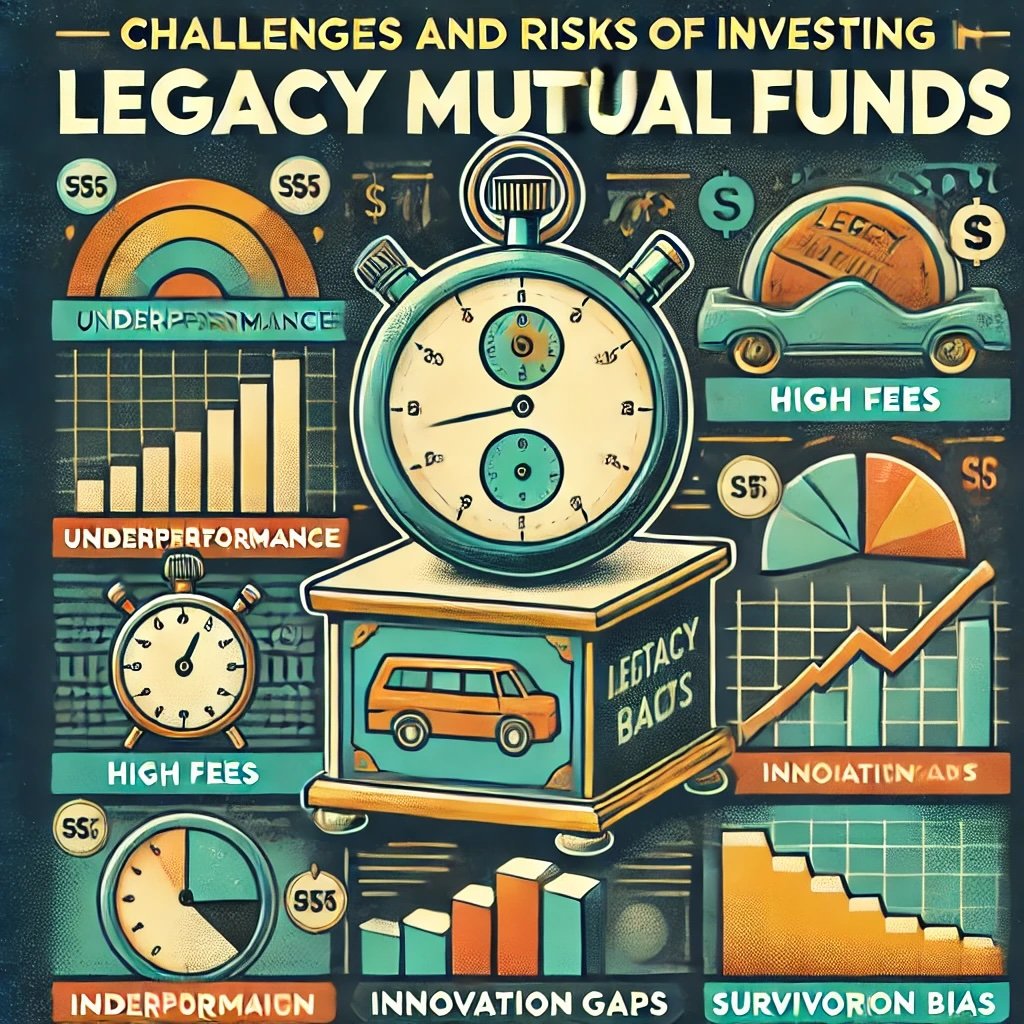
Challenges and Risks of Investing in Legacy Mutual Funds
So far, we’ve focused on the strengths of legacy mutual funds—their proven performance, seasoned management, strong reputations, and resilience. However, no investment is without drawbacks. Even the oldest, most trusted funds can falter under certain conditions or fail to deliver the returns investors might expect. Understanding these challenges is essential if you want a balanced, well-informed perspective. Below are some of the key pitfalls or risks you should keep on your radar.
1. Underperformance in Certain Cycles
While a decades-long track record may be impressive, it doesn’t guarantee outperformance in every market cycle. A fund known for blue-chip stocks might miss out on surging small-cap gains. A growth-focused legacy fund could underperform if the market shifts heavily toward value investing. Likewise, an index fund tracking the S&P 500 might lag global or sector-specific funds during periods when U.S. large-cap stocks underperform.
No one wins all the time.
2. Fee Structures
Older mutual funds sometimes have expense ratios that are higher than newer index-based ETFs or more modern funds. Although many legacy funds have reduced fees over time (responding to competition), some actively managed products still charge around 0.8% or 1% annually, which can be steep compared to a broad-market ETF charging 0.05%–0.15%. Over the long haul, these fee differences can eat into net returns. Additionally, some legacy funds have front-end or back-end loads (sales charges) that deter cost-conscious investors.
3. Innovation Gaps
It’s no secret that newer fund companies often leverage cutting-edge algorithmic trading, machine learning, or advanced risk management techniques. While legacy funds can adopt new technologies or refine their strategies, they sometimes move more slowly due to bureaucratic processes or a desire to maintain a consistent approach. In a rapidly evolving market, slow adaptation might mean missed opportunities or outdated methodologies.
4. Survivorship Bias
When we highlight successful old funds, we’re focusing on those that made it through decades of shifting market conditions. But it’s crucial to remember that many funds launched in the same era simply didn’t survive. They either merged, closed, or failed due to underperformance. This creates a survivorship bias, meaning the funds we see today are the “winners,” and it’s easy to overestimate how common it is for an old fund to be good.
5. Investor Over-Reliance on Historical Performance
A fund’s stellar track record might tempt investors to allocate large chunks of their portfolio, assuming “what worked before will keep working.” However, changing economic landscapes, manager transitions, and evolving market structures can all affect future returns. Indeed, the famed disclaimer—“Past performance does not guarantee future results”—applies strongly here. Putting too much faith in historical data can blind you to shifts in the fund’s underlying strategy, market competition, or global macroeconomic changes.
6. Potential for Style Drift
Some older funds, initially created with a particular style (e.g., value, growth, balanced), might drift over time. This can be due to changes in management, a desire to chase hot sectors, or simply a gradual evolution as their asset base expands. This “style drift” can catch investors off-guard if they selected the fund specifically for its original mandate.
7. The Impact of Big Asset Bases
Success can sometimes be a curse. When a fund amasses tens of billions of dollars in assets, it might struggle to move in and out of positions without affecting market prices. Large funds may also find fewer opportunities in smaller, higher-growth stocks—this can reduce flexibility and lead to more “index-like” performance, even if the fund aims to be actively managed.
Balancing the Risks
Ultimately, every investor has to weigh the trade-offs. Legacy funds deliver stability, brand name confidence, and a proven track record, but they might come with higher fees or an inability to pivot quickly when markets demand. Many longtime investors look at these factors and still choose to stick with or even expand their positions in legacy funds, believing that the benefits (and the overall historical returns) outweigh the downsides. Others diversify, holding a mix of legacy funds, low-cost ETFs, and even alternative investments.
The key takeaway is straightforward: understanding a fund’s composition, strategy, fee structure, and historical patterns is critical—whether it’s a brand-new thematic ETF or a decades-old legend. By doing your due diligence, you’ll be in a better position to evaluate whether a particular legacy mutual fund aligns with your personal investing style and risk tolerance.
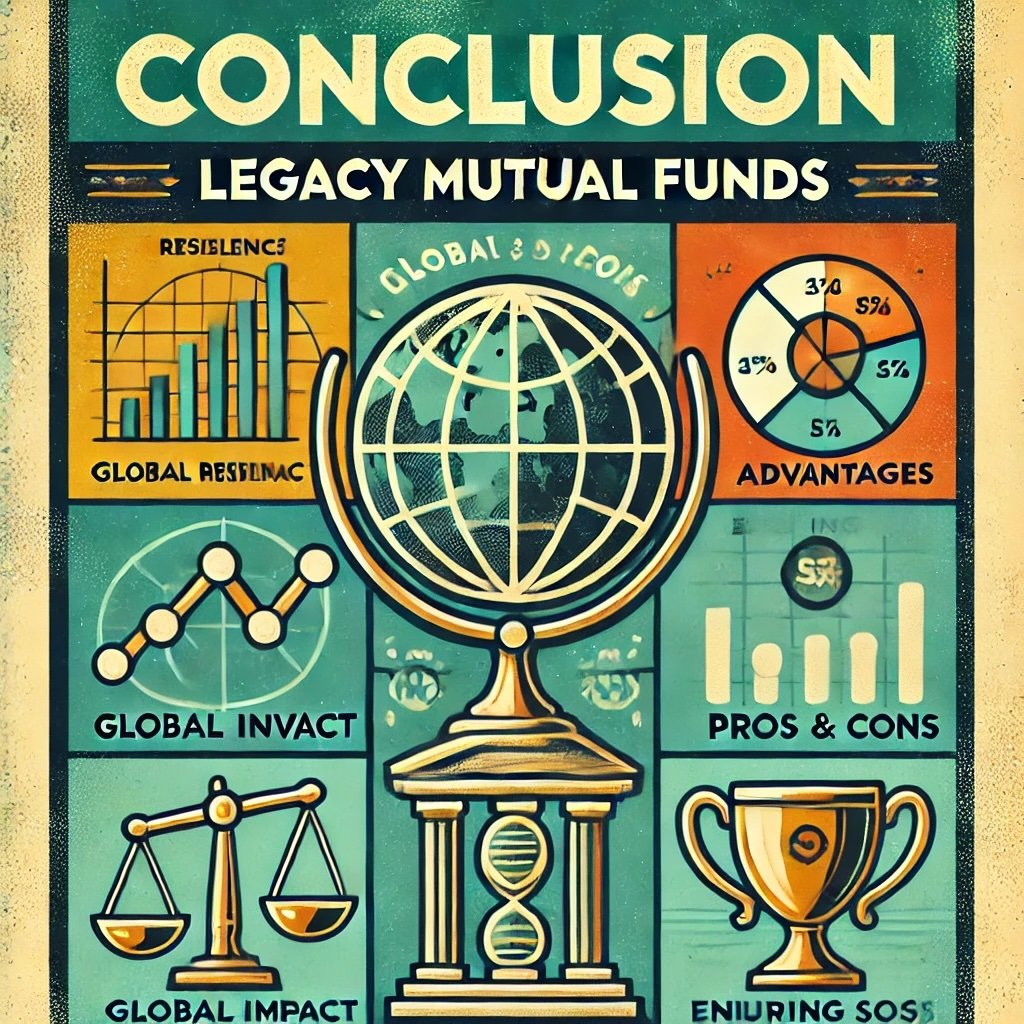
Legacy Mutual Funds: 12-Question FAQ
What is a “legacy” mutual fund?
A long-standing fund (often 20–50+ years old) with a deep performance record across multiple market cycles, typically run by established families (e.g., Vanguard, Fidelity, T. Rowe Price, American Funds) and supported by institutional research and repeatable processes.
Why can old funds still outperform newer options?
Time-tested playbooks, stable research teams, disciplined risk controls, and scale advantages (trading, research access) can compound small edges over decades—especially in core, large-cap or balanced mandates that reward consistency.
What are hallmark traits to look for in a legacy fund?
Clear mandate and style, experienced managers or team-process continuity, low turnover where appropriate, competitive expenses for its category, strong stewardship (shareholder-friendly culture), and outcomes that match stated objectives over full cycles.
How do fees compare with modern ETFs?
Index ETFs often win on raw expense ratio. Many legacy index funds are also very low cost; some legacy active funds still charge higher fees. The key is net returns after fees across full cycles, not fee alone.
Do legacy funds still use loads?
Some share classes at certain families carry front-end or back-end loads, especially when sold via brokers. No-load or institutional/Admiral classes often exist. Always select the lowest-cost eligible share class.
Are legacy funds tax-efficient?
Index legacy funds can be very tax-efficient; active legacy funds may realize gains from turnover or redemptions. ETFs often have structural tax advantages. Consider holding active legacy funds in tax-deferred accounts if tax drag is a concern.
How do manager changes affect legacy funds?
Risk rises when a star manager departs, but many legacy shops run team-based or committee models with deep benches and documented processes—reducing key-person risk. Review transition notes, co-manager tenures, and process continuity.
What risks are unique to legacy funds?
Style drift over time, large asset bases reducing agility, complacency vs. innovation, higher-than-ETF expenses in some classes, and survivorship bias (we mostly see the winners that endured).
When might a legacy fund be the better tool?
As a core holding for retirement/long-horizon accounts; when you value oversight, shareholder reports, and guardrails; where an experienced active process has historically added value vs. simple indexing in that segment.
How do I evaluate a legacy fund quickly?
Check mandate fit, fees (and available share classes), long-term risk/return vs. a relevant benchmark and peers, downside capture across bear markets, manager/committee tenure, turnover, and stewardship ratings or culture cues.
Should I pair legacy funds with ETFs?
Often yes. Many investors anchor with a low-cost index (ETF or mutual fund) and complement with one or two legacy active funds where the manager/process has shown durable edge; this blends cost control with selective alpha.
Where should I hold them (account type)?
Taxable accounts favor tax-efficient index funds/ETFs; higher-turnover active legacy funds often fit better in tax-advantaged accounts (IRA/401(k)). Always weigh after-tax, after-fee outcomes.
Conclusion
Legacy mutual funds have traversed a long road, evolving from humble beginnings to global powerhouses that collectively manage trillions of dollars. They’ve weathered numerous market storms—often more than a few—and come out on the other side with solid performance records and loyal investor bases. For many individuals, these funds represent a cornerstone in their portfolios: a testament to the power of steady growth, reliable management, and the staying power of well-established brand names.
Key points to remember:
- Defining Legacy Funds: They’re typically older than 20 years and hold a notable place in the history of the mutual fund industry. Some, like the Vanguard 500 Index Fund or Fidelity Contrafund, have pioneered strategies that remain influential.
- Advantages: Longevity often equals trust. That can translate into seasoned managers, high levels of diversification, and an established track record. Many older funds exhibit resilience during downturns, and their reputations can reassure investors who prefer a tried-and-true approach.
- Notable Standouts: Vanguard 500 Index Fund, Fidelity Contrafund, American Funds Growth Fund of America, and T. Rowe Price Blue Chip Growth. Each has carved out a distinct identity, showcasing how different strategies—whether indexing or active management—can succeed over the long haul.
- Risks: Being old doesn’t guarantee future success. Some legacy funds charge higher fees, may underperform in certain market cycles, or fail to keep pace with modern innovations. Survivorship bias can skew perceptions, and over-reliance on past performance might lead to disappointment if market dynamics shift drastically.
- Balancing Modern Tools: While legacy mutual funds can serve as solid “core” holdings, today’s investors often blend them with lower-cost ETFs, sector-specific funds, or alternative assets to craft a well-rounded portfolio that leverages both time-tested stability and cutting-edge strategies.
Neither old nor new is inherently superior.
Ultimately, mutual fund investing remains a personal decision, influenced by each investor’s goals, risk tolerance, and philosophical approach. Some prefer “buy and hold” strategies—valuing consistency and brand trust—while others gravitate toward niche products or high-octane strategies in pursuit of bigger gains. There’s room for both. Indeed, a savvy investor might hold a mix of legacy mutual funds for reliability and newer, specialized ETFs for targeted growth.
If you’re seeking a steady hand to guide a portion of your portfolio through bull and bear markets alike, a legacy mutual fund might be exactly what you need. It can offer decades of institutional wisdom, a well-defined strategy, and a measure of comfort in knowing that it has “been there, done that.” But be sure to look under the hood, stay alert to fee structures, and periodically review the fund’s performance to confirm it aligns with your evolving goals. After all, no matter how celebrated its history, an investment should continually earn its keep in your portfolio.
One thing is certain: these old funds aren’t going anywhere soon. They’ve stood the test of time for a reason, and many show every intention of continuing to innovate or refine their approaches. So the next time you’re considering your portfolio allocation, don’t dismiss a legacy mutual fund simply because it’s “old.” In many cases, “old” can mean time-tested, reliable, and still very much relevant in today’s fast-paced financial world.
Important Information
Comprehensive Investment Disclaimer:
All content provided on this website (including but not limited to portfolio ideas, fund analyses, investment strategies, commentary on market conditions, and discussions regarding leverage) is strictly for educational, informational, and illustrative purposes only. The information does not constitute financial, investment, tax, accounting, or legal advice. Opinions, strategies, and ideas presented herein represent personal perspectives, are based on independent research and publicly available information, and do not necessarily reflect the views or official positions of any third-party organizations, institutions, or affiliates.
Investing in financial markets inherently carries substantial risks, including but not limited to market volatility, economic uncertainties, geopolitical developments, and liquidity risks. You must be fully aware that there is always the potential for partial or total loss of your principal investment. Additionally, the use of leverage or leveraged financial products significantly increases risk exposure by amplifying both potential gains and potential losses, and thus is not appropriate or advisable for all investors. Using leverage may result in losing more than your initial invested capital, incurring margin calls, experiencing substantial interest costs, or suffering severe financial distress.
Past performance indicators, including historical data, backtesting results, and hypothetical scenarios, should never be viewed as guarantees or reliable predictions of future performance. Any examples provided are purely hypothetical and intended only for illustration purposes. Performance benchmarks, such as market indexes mentioned on this site, are theoretical and are not directly investable. While diligent efforts are made to provide accurate and current information, “Picture Perfect Portfolios” does not warrant, represent, or guarantee the accuracy, completeness, or timeliness of any information provided. Errors, inaccuracies, or outdated information may exist.
Users of this website are strongly encouraged to independently verify all information, conduct comprehensive research and due diligence, and engage with qualified financial, investment, tax, or legal professionals before making any investment or financial decisions. The responsibility for making informed investment decisions rests entirely with the individual. “Picture Perfect Portfolios” explicitly disclaims all liability for any direct, indirect, incidental, special, consequential, or other losses or damages incurred, financial or otherwise, arising out of reliance upon, or use of, any content or information presented on this website.
By accessing, reading, and utilizing the content on this website, you expressly acknowledge, understand, accept, and agree to abide by these terms and conditions. Please consult the full and detailed disclaimer available elsewhere on this website for further clarification and additional important disclosures. Read the complete disclaimer here.

